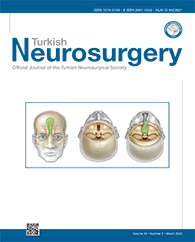Current Issue: 2024
Volume 34, Number 2
| Editor-in-Chief | : Cem Yılmaz |
| ISSN | : 1019-5149 |
| e-ISSN | : 2651-5032 |
| Publishing Frequency | : Six (6) issues per year |
| (Bi-monthly: January, March, May, July, September and November) | |
Turkish Neurosurgery
Radiological and Clinical Outcomes of Transforaminal vs. Posterior Lumbar Interbody Fusions: A Systematic Review
Identification of Driver Genes and Key Pathways of Ependymoma
LncRNA MALAT1 Promotes Neuronal Apoptosis During Spinal Cord Injury Through miR-199a-5p/ PRDM5 Axis
MiRNA-384-5p Targets GABRB1 to Regulate Ketamine-Induced Neurotoxicity in Neurons
Survival Outcome and Prognostic Factors of Primary Spinal Cord Lymphoma
LncRNA FOXD3-AS1 Contributes to Glioblastoma Progression Via Sponging miR-3918 to Upregulate CCND1
Quantitative Anatomic Analysis and Clinical Application of Lumbar Spinous Process Split Laminotomy
Novel Indices for Lumbar Discectomy: Systemic Immune Inflammation Index, Systemic Inflammatory Response Index, Multi Inflammatory Index, and Prognostic Nutrition Index
Evaluation of Percutaneous Unilateral Kyphoplasty Results in Osteoporotic Vertebral Compression Fractures Using Individual 3D Printed Guide Template Support
Is The Modular Dynamic System as Effective as Classical Dynamic Systems in Long Segment Dynamic Thoracolumbar Stabilization?
The Effects of Regulating Increased Blood Glucose Levels on Plasma Endothelin-1 Levels After Severe Head Trauma in Rats
Middle Cerebral Artery Ischemic Complications After Flow Diverter Deployment from Internal Carotid Artery Extending into M1 Segment
Risk Factors Associated with Cage Retropulsion After Lumbar Interbody Fusion
Intraventricular Hemorrhage and Related Hydrocephalus Patients Demographics in a University Hospital NICU: Single-Center Data
Risk Factors for Specific Postoperative Ischemic Complications in Patients with Moyamoya Disease: A Single-Center Retrospective Study
Low-Level miR-199 Contribute to Neuropathic Low Back Pain via TRPV1 by Regulating the Production of Pro-Inflammatory Cytokines on Macrophage
Comparative Analysis of Ultrasound-Assisted Precise Localization vs. Traditional Open Incision in Situ Decompression for the Treatment of Cubital Tunnel Syndrome
Effects of Focal Cerebellar Injury on Fracture Healing and Oxidative Stress in Rat Model: An Experimental Animal Study
Analysis of Neurosurgical Injuries and The Lessons Learned After the Catastrophic Double Earthquakes in Turkey
Effect of Resection and Surgical Experience on Survival in Patients with Craniopharyngiomas: Endoscopic Transsphenoidal Surgery in Series of 31 Cases
Effects of Transcranial Direct Current Stimulation on Motor and Cognitive Dysfunction in an Experimental Traumatic Brain Injury Model
Paramedian Forehead Flap for Repair of Refractory High-Flow Anterior Skull Base CSF Leak
Multiple Intracranial Aneurysms Concurrent with a Clinoid Meningioma: A Case Report
Embolization of a Non-Galenic Pial Arteriovenous Fistula with Assistance of a SolitaireTM Stent: Case Report
COVID-19 Vaccine Related Cervical Radiculitis and Parsonage-Turner Syndrome: Case Report and Review of the Literature







